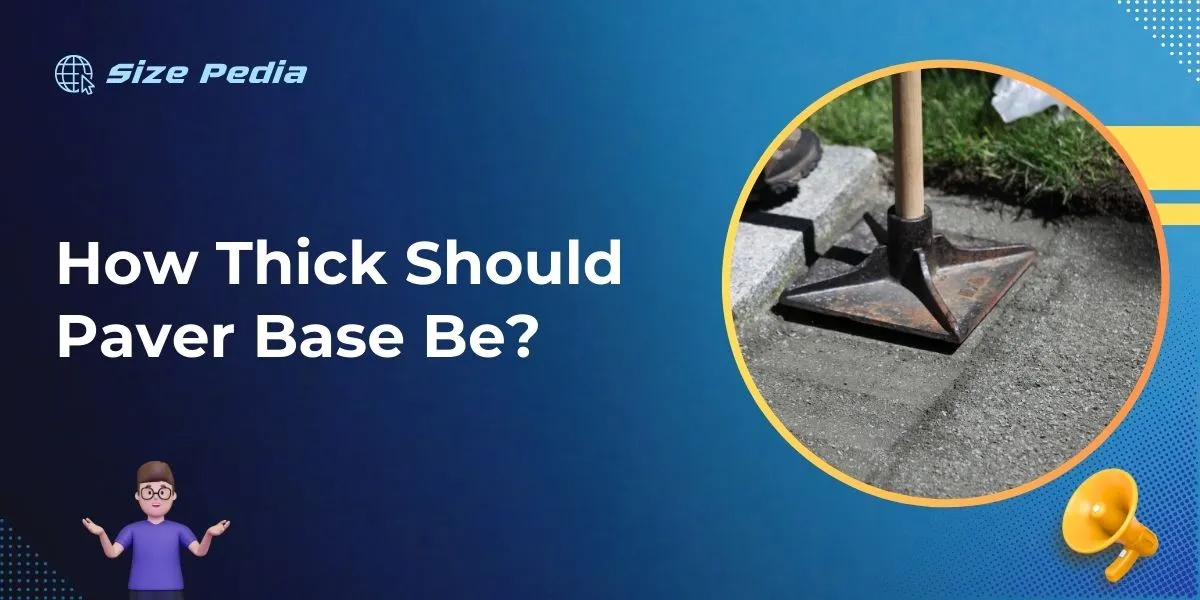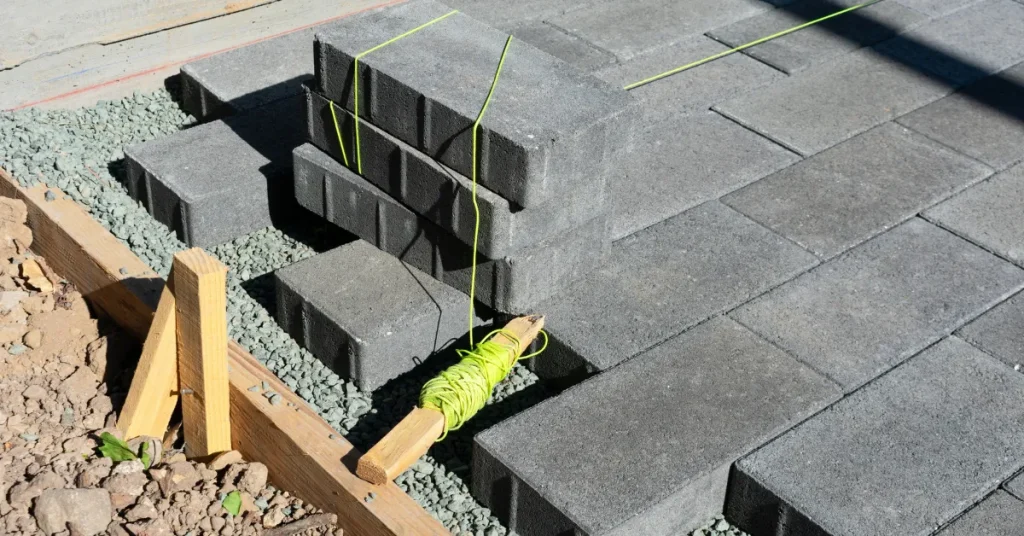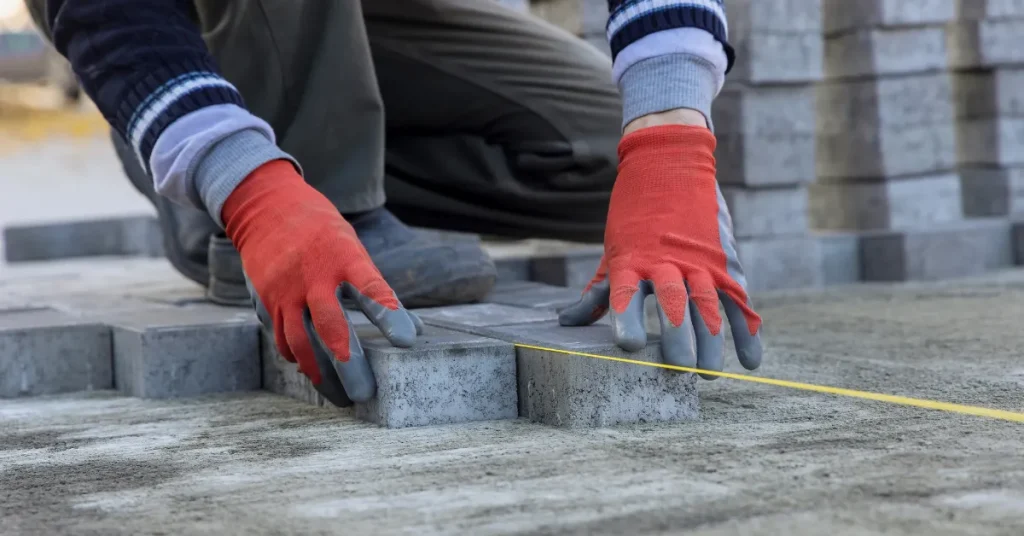A paver base should be at least 4 inches thick for walkways and 6-8 inches for driveways. The precise thickness depends on the soil type and load requirements.
Creating a solid foundation for your paver project is key to its longevity and durability. Whether you’re planning to install a charming walkway through your garden or a sturdy driveway for your vehicles, understanding the importance of a proper paver base is essential.
It’s the unsung hero that supports your pavers, ensuring they remain level and avoid shifting over time. With a well-prepared base, your paving stones will withstand the elements and foot traffic, keeping their aesthetic appeal and functionality for years to come.
Embrace these crucial inches beneath your pavers—it’s the groundwork to a successful paving project that enhances your outdoor living space.

Ideal Paver Base Thickness
Creating a beautiful, durable patio or walkway begins with the right foundation. The ideal paver base thickness is essential for long-lasting results.
A proper base ensures stability, prevents sinking, and supports heavy loads. Let’s explore what contributes to the perfect paver base thickness.
Factors Influencing Thickness
Determining the perfect paver base thickness depends on multiple factors. Here’s a list to consider:
- Soil Type: Sandy soils require less thickness while clay-based soils need more.
- Load Expectations: Driveways bear more weight than garden paths.
- Frost Line: Colder regions need a thicker base to prevent frost heave.
- Paver Size and Type: Large or interlocking pavers may need a more substantial base.
Recommended Depths For Stability
Depending on the application, different base depths are recommended. The table below outlines these recommendations:
| Application | Base Depth |
| Walkways | 4 inches |
| Patios | 4-6 inches |
| Driveways | 8-12 inches |
For stability, always compact the base material. It should consist of crushed stone or gravel. This ensures your pavers remain level and secure for years.
Material Choices For Paver Base

Choosing the right material for a paver base is critical to the longevity and stability of the paved area. A solid foundation is as crucial as the pavers above it.
The base must support the surface through seasons and use. To ensure a lasting enjoyment of the paved space, let’s focus on suitable materials for constructing a robust paver base.
Gravel And Crushed Stone Options
Gravel and crushed stone serve as strong foundation layers. They provide excellent drainage and prevent shifting. Proper compaction of these materials enhances their strength. They should comply with specific sizes and composition. Your options might look like this:
- Crushed Stone #411: A mixture of stone dust and #57 stone.
- Crushed Rock #57: Roughly the size of a nickel or quarter.
- Quarry Process: Stone dust mixed with crushed stone, binds when compacted.
The thickness of gravel or crushed stone layers typically ranges from 4 to 6 inches. However, consult local guidelines for specific depth recommendations.
Sand As A Layering Choice
After the gravel or stone, sand acts as a finesse layer. It fills voids and holds the pavers in place. Aim for uniformity in thickness and texture. Coarse concrete sand is generally the go-to for this layer.
| Sand Type | Average Thickness |
| Coarse Concrete Sand | 1 to 1.5 inches |
The ideal sand should not be too fine, as it can lead to erosion. Proper compaction of the sand layer provides a final, smooth surface onto which pavers can be laid directly.
Preparation Steps For Paver Base Installation
Creating a stable foundation for pavers begins with preparation. A well-prepared base is critical to the longevity and durability of any paving project.
Preparation steps ensure the pavers will remain flat and secure for years. Delve into the initial steps to guarantee a solid paver base installation.
Site Clearing And Excavation
First, clear the project site of all vegetation and debris. Mark the area with stakes and string to outline the paver’s location. Then, excavate the area to the desired depth, which typically includes the paver thickness, the base thickness, and the sand bed.
Ensure the excavation is level to avoid water pooling beneath the pavers.
- Remove grass, roots, and organic soil.
- Set boundaries with stakes and string.
- Excavate to the correct depth.
- Ensure a level surface to prevent drainage issues.
Achieving Proper Compaction
Proper compaction is critical to the paver base’s strength. Begin by dampening the soil slightly to help in the compaction process.
Rent or purchase a plate compactor to ensure the soil is compacted evenly and thoroughly. Multiple passes with the compactor may be necessary to achieve the desired density.
- Moisten the ground lightly for better compaction.
- Use a plate compactor for a flat surface.
- Make several passes to achieve solid ground.
Enhancing Paver Longevity And Durability
Building strong, lasting pavers is key to a great outdoor space. Proper base thickness is crucial. It ensures stability and fights sinking. Aim for a base that can stand up to weather and pressure.
Weed Barriers And Edge Restraints
Weed barriers prevent growth under pavers. They keep the base solid. This means less repair down the line. Edge restraints are also important. They hold pavers in place.
- Choose quality barriers.
- Install them below the base.
- Use edge restraints around the perimeter.
This method increases your paver’s life span. It saves time and money.
Maintenance Tips For A Sturdy Paver Base

A strong foundation is essential. With regular maintenance, pavers can last years.
| Step | Action |
| 1 | Check for unevenness. |
| 2 | Remove damaged pavers and fix the base. |
| 3 | Compact the base regularly. |
Follow these steps for a base that stays firm. Enjoy your outdoor space without worry.
Common Mistakes To Avoid During Installation
Building a beautiful patio or walkway is exciting. But a great project starts with avoiding common installation errors. Keep in mind, the strength of your project lies underground. Let’s dig into those mistakes you should steer clear from to ensure a lasting installation.
Insufficient Base Thickness
One key step often overlooked is the paver base thickness. A solid foundation is critical for longevity. Here’s what to remember:
- Aim for 4-6 inches of base material for pedestrian areas.
- Driveways need up to 12 inches for adequate support.
- Shortcuts lead to sinking and shifting pavers.
Always measure the depth after compaction. Base materials compress, so start thicker to end up just right.
Inadequate Compaction And Drainage
Your base isn’t just about thickness. Compaction and drainage play pivotal roles too. Incorrect compaction or poor drainage can ruin a project. Below are the crucial points:
| Compaction | Drainage |
| Use a plate compactor for even results.Multiple passes ensure solid ground.Compacting in layers leads to better stability. | Ensure a slight slope away from structures.Implement drainage systems if needed.Standing water means trouble. Avoid flat areas. |
Both compaction and drainage are not just one-time checks. Maintain vigilance throughout installation, and check regularly.
FAQs About How Thick Should Paver Base Be
Is 2 Inches Of Paver Base Enough?
No, 2 inches of paver base is not enough. For proper support and to prevent settling, most projects require a 4 to 6-inch layer of paver base.
How Thick Should A Paver Base Be For A Patio?
A paver base for a patio should typically be 4-6 inches thick for proper support and stability.
What Is The Best Base For Pavers?
The best base for pavers is a well-compacted layer of crushed stone topped with sand. This foundation ensures stability and proper drainage for long-lasting paver installations.
Does Paver Base Need To Be Perfectly Level?
Paver base should be level, but perfection isn’t required. Minor variances are acceptable as they allow for proper drainage and paver alignment during installation. Ensuring a generally flat surface is key for long-lasting, stable pavers.
Conclusion
Selecting the correct paver base thickness is crucial for a durable, stable surface. Aim for a 4-6 inch base for walkways and patios, and 8-12 inches for driveways.
Proper installation ensures longevity and reduces repairs. Achieve your project’s success by following these guidelines for a solid paver base.
Resources:
1.https://extension.oregonstate.edu/sites/default/files/documents/1/howtoinstallpavers.pdf
